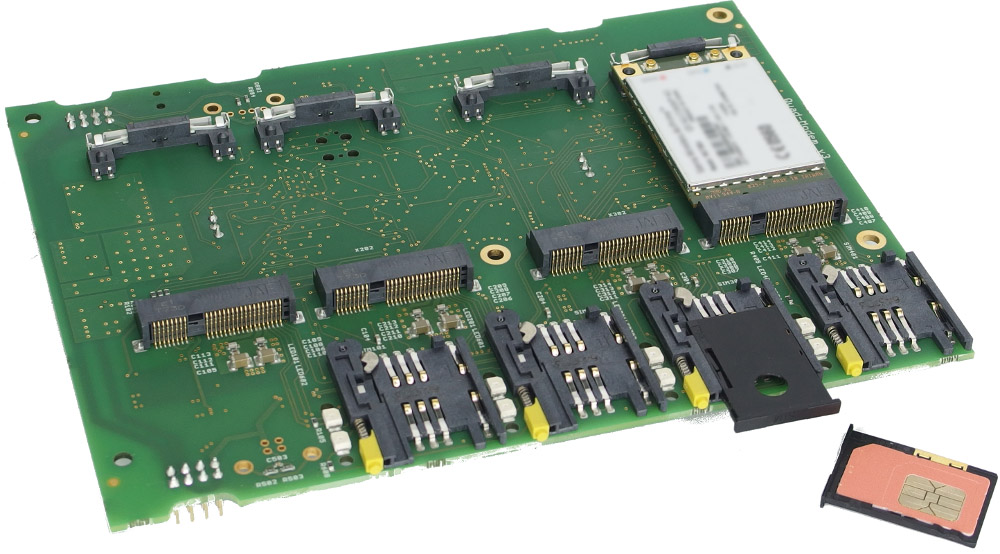
SysmoQMOD board for four LTE modems
Nine years ago, legendary programmer Fabrice Bellard developed LTEENB - LTE Base Station Software : a software emulator of a 4G LTE base station on a regular PC using available radio equipment. Thanks to it, the LTE base station can technically be used as a regular WiFi hotspot.
Unfortunately, either someone bought all the rights to Bellard's developments, or he was pressed by law enforcement agencies, but the description of the LTE Tools and the documentation for the LTEMOD frequency generator disappeared from Fabrice's website.
Now the guys from the non-profit project LibreCellular though repeat his work. They set out to assemble a complete LTE base station from available components and free software.

Bellard's base station supported LTE Release 8 with full duplex FDD , 1.4 MHz to 20 MHz, and implemented LTE PHY, MAC, RLC, PDCP, RRC and NAS protocols. During testing, a PC running Linux on a 2.93 GHz Core i7 processor successfully coped with real-time data processing. Radio equipment: USRP N210 with SBX radio transmitter board . Antenna: Band 7 (2600 MHz FDD), 20 MHz band.

Bellard's client equipment: Huawei E398 4G LTE USB modem (Qualcomm MDM9200 chipset). During testing on the client modem, a speed of 60 Mbps was recorded for downloading, 25 Mbps for downloading. Fabrice Bellard offered LTE Tools on request to interested companies .
LibreCellular follows the original idea in many ways. Unlike a conventional femtocell, such an LTE base station can be connected via Ethernet to a wired channel of any Internet provider. And although the project seems somehow hacker and illegal, in reality it is partially funded by the European grant NGI Zero - Privacy Enhancing Technologies .
LibreCellular's goal is to develop a complete hardware and software solution that is relatively easy to deploy in real-world conditions and will work reliably. The list of components is preliminary delineated, but it is subject to change.
Hardware and software stack
It is intended to use common off-the-shelf hardware and software radios, providing a platform for continued ongoing development with community participation.
Each station is a small cell in the 1.4 MHz and 3 MHz bands.
Cells will initially only support data transmission. In the future, it is planned to implement voice support via VoLTE (HD voice) and CSFB (Circuit Switched FallBack).
Hardware stack

All components fit in one 19 "rack. Subsystems are as follows :
- RFTST - radio frequency testing and measurement;
- TSTCON - testing controller;
- RANLS1 (base station LimeSDR # 1) and RANLS2 (base station LimeSDR # 2;
- CLKDST - clock pulse distribution;
- RF4AT4 - 4x to 4x RF splitter / combiner plus sysmoRFDSATT-4-62;
- MOD8SQ - a cluster of eight LTE modems, namely two sysmoQMOD boards (on KDPV);
- MOD4QV - a cluster of four LTE modems with VoLTE support;
- DCPSU1 is a common DC power supply.
Automated testing - using OsmoGSMTester . Testing coverage will expand as the project develops.
Reference hardware platform
- Intel NUC7i7DNBE Direct Channel Processor for bandwidth processing and triggering the upper layers of the cellular stack.
- LimeSDR-USB board for software radio

LimeSDR-USB board
- RF front-end LimeRFE board complete with LNA, PA and duplexers will provide 24 dBm modulated output over multiple bands

LimeRFE board
- The LimeSDR uses Leo Bodnar's Mini Precision GPS Reference Clock for stable and accurate pulse generation. Mini Precision GPS

Clock Reference
Software stack
The key software components in the pre-stack are listed below. This is not a complete list:
- eNodeB - component of 4G base station from srsRAN ;
- Open5GS for the core network;
- Multimedia Subsystem (IMS) - opensorsny server Kamailio .
How much does a license cost
To run your base station, you need to obtain a license. Frequency allocation and licensing in each country is handled by a government agency such as Ofcom Shared Access in the UK and CBRS in the US. For example, below are the annual channel licenses for the bands from 1800 MHz, 2300 MHz, 3.8 to 4.2 GHz in the UK, depending on the frequency band.
| Frequency band | Price |
|---|---|
| 2x3.3 MHz | ? 80 |
| 10 MHz | ? 80 |
| 20 MHz | ? 160 |
| 30 MHz | ? 240 |
| 40 MHz | ? 320 |
| 50 MHz | ? 400 |
| 60 MHz | ? 480 |
| 80 MHz | ? 640 |
| 100 MHz | ? 800 |
In the 26 GHz band, the annual license costs £ 320 regardless of frequency band.
You can buy a license for less than a year. The cost is calculated in proportion to the number of months, but minimum? 32 per license.
It's hard to believe that the guys from LibreCellular will be able to repeat Fabrice Bellard's project, after all, he has a very high level of talent and skill. Here is a list of some of Fabrice's projects:
- 1989: LZEXE
- 1996: Harissa
- 1997: Publication of Bellard's formula for calculating digits of pi
- 1999: Linmodem
- 2000: Calculating the largest known prime number (source 438 bytes)
- 2000: FFmpeg
- 2001: TCC (Tiny C Compiler TinyCC)
- 2002: TinyGL
- 2002: QEmacs
- 2003: QEMU
- 2004: TinyCC
- 2005: DVB-T
- 2009:
- 2011: Linux JavaScript
- 2012: LTEENB – LTE Base Station Software
- ...
